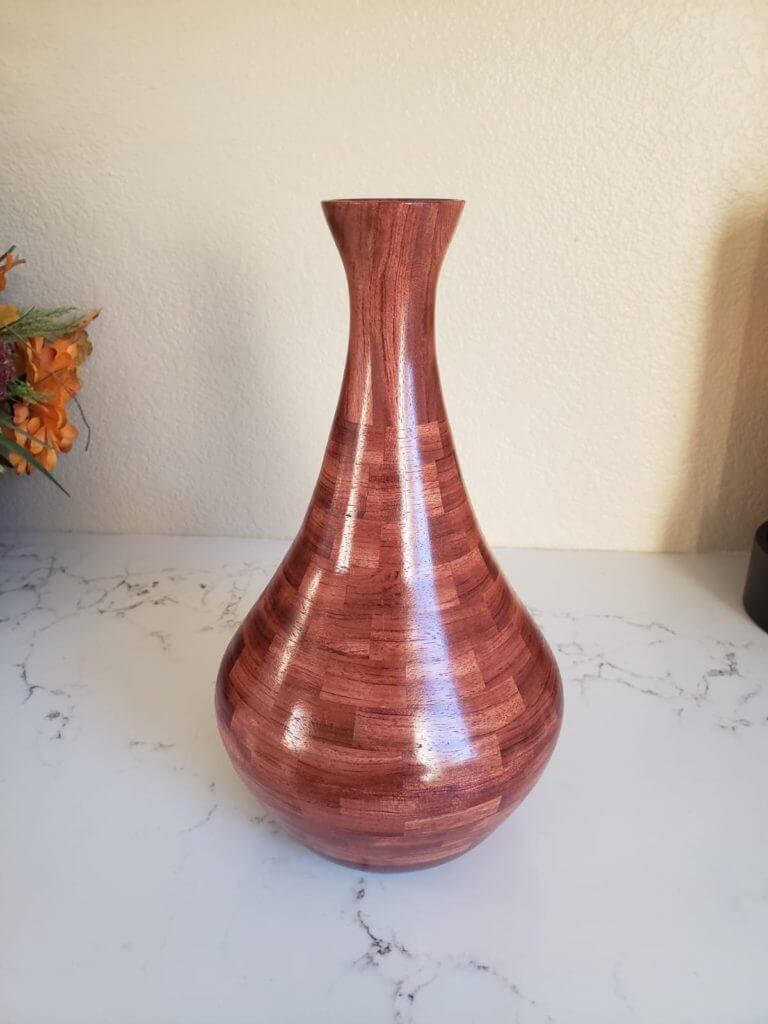These Free segmented turning plans and calculations are copyright free. I invite anyone to use them. The only thing I ask is that you send me a picture of your vase if you make one. This particular version of the “Genie Vase” is made from Babinga.

The woods used:
Spalted Maple, North America.
Padauk: The red colored wood. Africa.
Yellowheart: The Yellow colored wood. Africa.
Purpleheart: The purple wood. South America
Wenge: This is the dark brown wood on the rim the base and the feature ring. Africa.
The Feature Ring
Step One:
Cut each of the following strips of wood 1-1/4 inches wide and 40 inches long. Run each board through a drum sander to be sure that they are flat.
- Strip 1, Wenge: 1″ thick.
- Strip 2, yellowheart: 1/2″ thick
- Strip 3, Padauk: 1/2″ thick.
- Strip 4, Purpleheart: 1/2″ thick.
- Strip 5, Yellowheart: 1/2″ thick.
- Strip 6, Wenge: 1″ thick.
Step Two:
- Glue and clamp strip 1 (wenge) to strip 2 (yellowheart).
- Glue and clamp strip 5 (yellowheart) to strip 6 (wenge).
- Glue and clamp strip 3 (padauk) to strip 4 (purpleheart).
- You now have three combined strips. let all there combined strips dry overnight.
At this point you should have the folloing three layered boards.
- 1″ Wenge + 1/2″ yellowheart .
- 1/2″ padauk+ 1/2″ purpleheart.
- 1″ Wenge + 1/2″ yellowheart
Step Three:
- After the glue dries, run each of the three strips through a belt sander to thin the yellow heart,padauk and purpleheart down to 3/8″ and sand the wenge smooth.
- Glue and clamp all three boards together to make one board such that the layers are ordered as shown in step one.

- Cut the board into 24 segments using compound angles. 45 degrees across the board as shown here by the white lines, and 7.5 degrees through the board to create a pie shaped segment. Each here are

You can tell by the picture that turning and finishing the inside of this vase is next to impossible due to the very narrow neck. Here are a few hints that that will help:
Start by gluing the bottom six rings together first. Turn and finish the inside of these six rings, leave the outside as a rough picture of its final shape.
Working down from the top of the vessel glue rings 11, 10, 9, 8, and 7 together. Then glue a temperary mounting block to ring 11.
Using the temporary mounting block, attach ring 11 to the lathe then turn and finish the inside of these top rings.
As you complete the turning of this half, be sure to take accurate measurements of the inside diameters so that they match the diameters of the bottom when you glue the top to the bottom.
Now go ahead and glue the top section of the vase to the bottom half of the vase. Next, remove the temperary mounting block from ring 11 and attach the final two rings.


The Final Finish
Finally, attach rings 12, 13 and 14 and complete the final turning, sanding and finishing the outside of the vase.
Finish turning the vase at around1700 rpm then sand to 400 grit and finish it with Danish Oil. Finally, polished with Carnauba Wax for a beautiful finish that any Genie would enjoy.
Genie Vase Plan
| Row | Type | # of segments | Segment thickness | Ring Diameter | Edge Length | Edge Width | Board length | Angle |
|---|---|---|---|---|---|---|---|---|
| 14 | Flat | 2 | 2" | 1-1/4" | 0" | 5/8" | 0" | 90 degrees |
| 13 | Flat | 10 | 1/2" | 1-19/32" | 17/32" | 9/16" | 4-5/32" | 18 degrees |
| 12 | Flat | 10 | 1/2" | 2" | 21/32" | 3/4" | 4-29/32" | 18 degrees |
| 11 | Flat | 10 | 1/2" | 2-1/2" | 13/16" | 29/32" | 6-1/8" | 18 degrees |
| 10 | Flat | 10 | 1/2" | 3" | 1" | 1-1/32" | 7-3/8" | 18 degrees |
| 9 | Flat | 10 | 1/2" | 3-3/4" | 1-7/32" | 1-5/32" | 9-13/32" | 18 degrees |
| 8 | Flat | 10 | 1/2" | 4-5/16" | 1-13/32" | 1-7/32" | 11-1/8" | 18 degrees |
| 7 | Flat | 10 | 1/2" | 5" | 1-5/8" | 1-3/16" | 13-3/8" | 18 degrees |
| 6 | Flat | 10 | 1/2" | 5-1/2" | 1-25/32" | 1-3/32" | 15-5/16" | 18 degrees |
| 5 | Flat | 10 | 1/2" | 5-3/4" | 1-7/8" | 1-3/32" | 16-1/8" | 18 degrees |
| 4 | Flat | 10 | 1/2" | 5-3/4" | 1-7/8" | 1-7/32" | 15-25/32" | 18 degrees |
| 3 | Flat | 10 | 1/2" | 5-1/4" | 1-23/32" | 1-3/32" | 14-17/32" | 18 degrees |
| 2 | Flat | 10 | 1/2" | 4-3/4" | 1-17/32" | 1-17/32" | 11-9/16" | 18 degrees |
| 1 | Disk | 1/2" | 3-1/2" |

